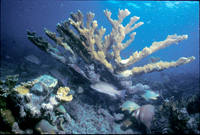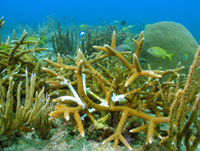NOAA Issues Stronger Protections for Elkhorn and Staghorn Corals in Southeast United States
October 28, 2008
High resolution (Credit: NOAA)
NOAA’s Fisheries Service will increase its protection of threatened elkhorn and staghorn corals in Florida, Puerto Rico, and the U.S. Virgin Islands through a new rule to prohibit activities that result in death or harm to either species. The new regulations take effect on Nov. 21.
These corals provide the branching framework for reef creatures in search of a safe place to live, eat, and grow. The preservation and recovery of these threatened corals is essential to the conservation of an entire ecosystem. Both elkhorn and staghorn corals were listed as threatened under the Endangered Species Act in May 2006.
“These corals were once the major reef builders in Florida and the Caribbean, but now more than 90 percent of their populations are lost,” said Roy Crabtree, NOAA’s Fisheries Service’s southeast regional administrator. “That not only threatens their survival — it affects the entire ecosystem. This rule will strengthen our efforts to recover these corals by allowing us to address the human-induced threats affecting their status.”
The rule will prohibit the import, export, take, and all commercial activities involving elkhorn and staghorn corals, including:
- collection or any activities that result in the corals’ mortality or injury;
- anchoring, grounding a vessel, or dragging any other gear on the species;
- damaging the species’ habitat;
- discharging any pollutant or contaminant that harms the species.
High resolution (Credit: NOAA)
Species listed as “endangered” under the ESA are covered by a suite of protective measures and prohibitions in the law. However, for species listed as “threatened,” such as elkhorn and staghorn corals, these same measures and prohibitions do not automatically apply. NOAA’s Fisheries Service has developed a separate rule under section 4(d) of the ESA that identifies the prohibitions necessary to conserve elkhorn and staghorn corals.
The rule will not prohibit scientific research and enhancement activities or restoration activities carried out or permitted by authorized agencies.
“We received a lot of input from our partners and constituents during the development of this rule,” said Jennifer Moore, a biologist for NOAA’s Fisheries Service. “That information helped shape a rule that will provide benefits and protections to maintain these corals for future generations.”
NOAA’s Fisheries Service also received 30 written comments during a 60-day comment period for the proposed rule, which was published in the Federal Register on Dec. 14, 2007.
In a related step toward conserving elkhorn and staghorn corals, NOAA’s Fisheries Service is finalizing the package that designates critical habitat for the species. A separate rule is expected to be issued that will require federal agencies to scrutinize whether their activities will destroy or adversely modify areas designated as critical habitat for threatened corals.
NOAA understands and predicts changes in the Earth's environment, from the depths of the ocean to the surface of the sun, and conserves and manages our coastal and marine resources.


